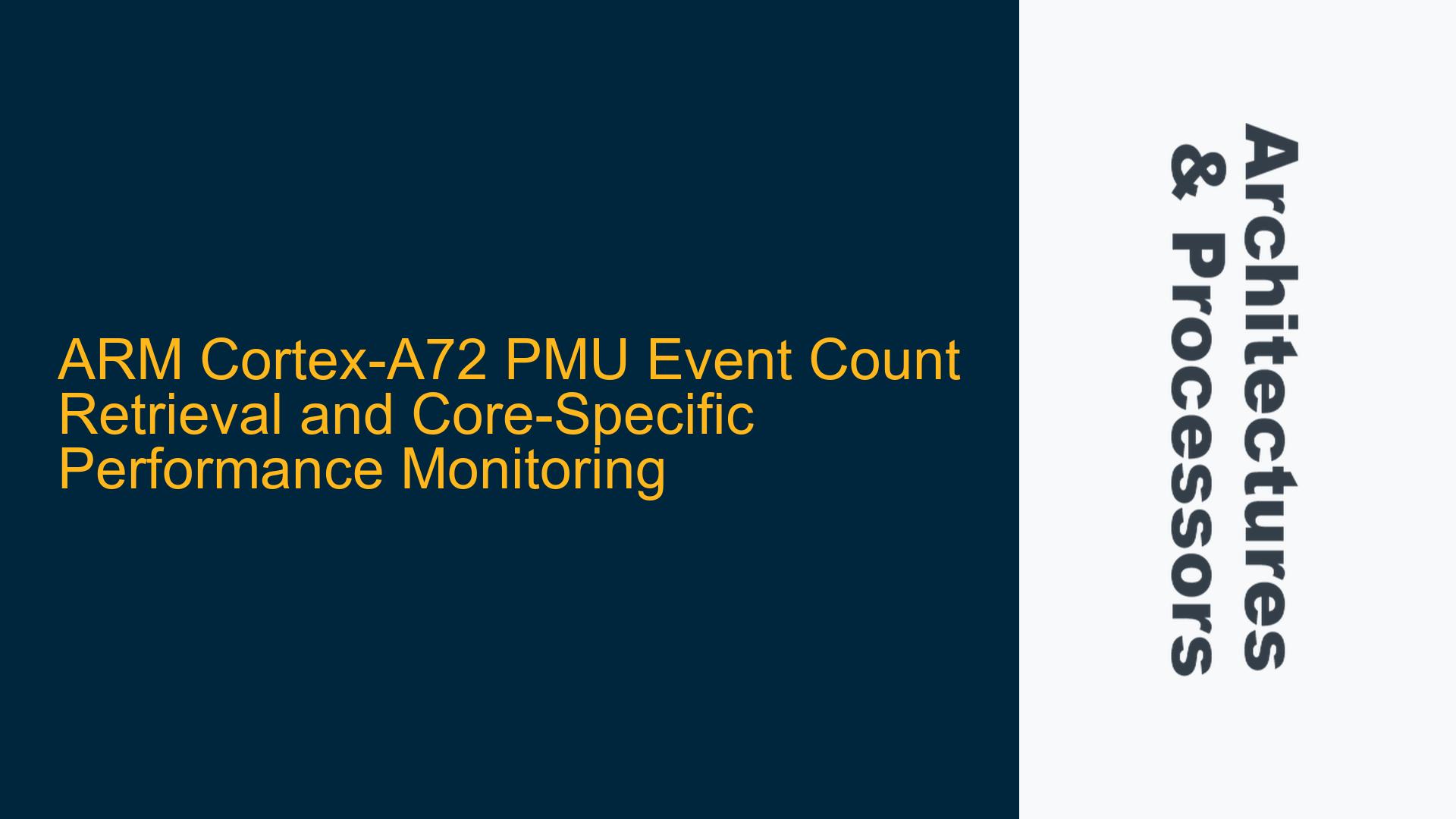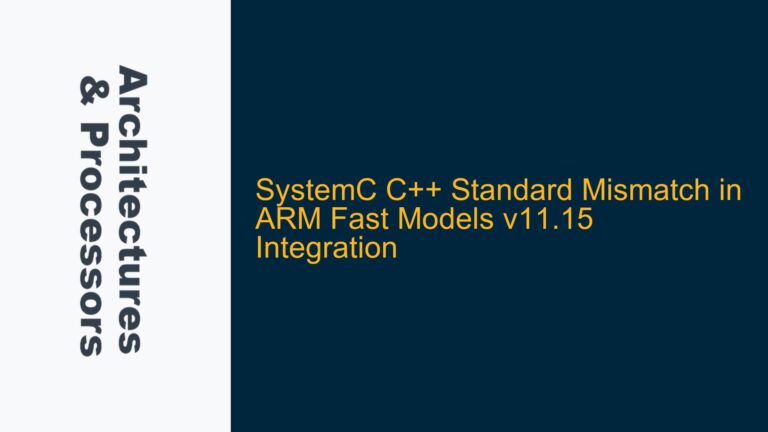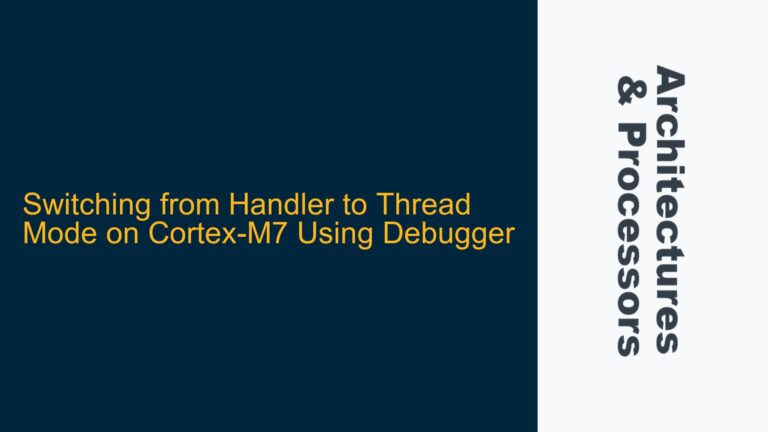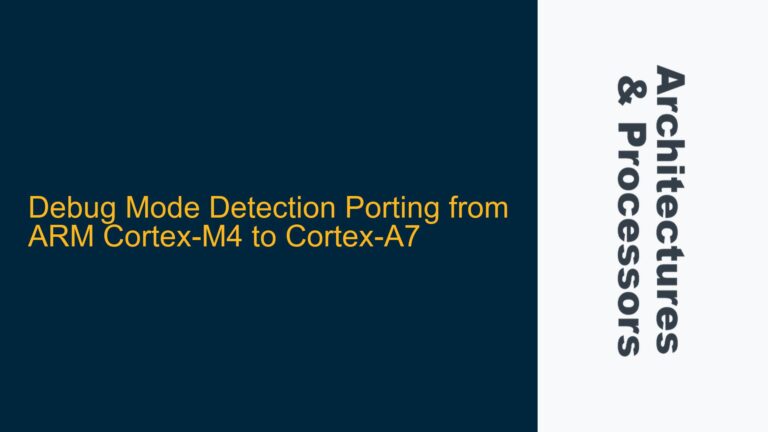ARM Cortex-A72 PMU Architecture and Event Counting Overview
The ARM Cortex-A72 processor is a high-performance CPU core designed for advanced applications, featuring a private Performance Monitoring Unit (PMU) for each of its four cores. The PMU is a critical component for profiling and optimizing system performance, as it allows developers to count specific hardware events such as cache misses, branch mispredictions, and instruction retirements. Each PMU operates independently, capturing events from the perspective of its associated core. This architecture enables fine-grained performance analysis but introduces complexity when attempting to aggregate or synchronize data across multiple cores.
The PMU registers are core-specific, meaning that each core can only access its own PMU registers directly. This design ensures that performance monitoring does not interfere with the execution of other cores but also means that retrieving event counts from all four PMUs requires a coordinated approach. The PMU registers are memory-mapped and can be accessed using specific instructions, such as MRS (Move to Register from System) and MSR (Move to System Register), which are part of the ARMv8-A instruction set.
Understanding the PMU architecture is essential for effective performance monitoring. Each PMU supports a configurable number of event counters, which can be programmed to track specific events. These counters are typically 32-bit or 64-bit wide, depending on the implementation, and can overflow if not handled properly. Additionally, the PMU includes control registers for enabling or disabling counters, configuring event types, and handling interrupts on counter overflow.
Core-Specific PMU Register Access and Synchronization Challenges
One of the primary challenges in retrieving PMU event counts from the ARM Cortex-A72 is the core-specific nature of the PMU registers. Since each core can only access its own PMU registers, developers must implement a mechanism to collect data from all four cores. This can be achieved through software running on each core or by using a debug unit capable of accessing all cores’ PMU registers.
The core-specific access limitation introduces synchronization challenges, particularly when attempting to correlate event counts across multiple cores. For example, if a developer wants to measure the total number of cache misses across all cores, they must ensure that the counters are read at approximately the same time to avoid discrepancies caused by differences in core activity. This requires careful coordination, often involving inter-core communication mechanisms such as mailboxes or shared memory.
Another consideration is the potential for counter overflow. PMU counters are finite in size and can wrap around if not monitored and reset periodically. To handle this, developers can configure the PMU to generate an interrupt on counter overflow, allowing the software to log the event and reset the counter. However, this adds complexity to the performance monitoring system, as the interrupt handler must be designed to minimize its impact on system performance.
Implementing PMU Event Count Retrieval and Best Practices
To retrieve PMU event counts from all four cores of the ARM Cortex-A72, developers can follow a structured approach that includes initialization, configuration, data collection, and synchronization. Below is a detailed guide to implementing PMU event count retrieval:
Initialization and Configuration
Before using the PMU, it must be initialized and configured. This involves enabling the PMU, setting up event counters, and configuring the events to be monitored. The following steps outline the initialization process:
- Enable the PMU: The PMU is disabled by default and must be enabled using the
PMCR_EL0(Performance Monitors Control Register). This register includes a bit for enabling the PMU and another for resetting all counters. - Configure Event Counters: Each event counter must be configured to track a specific event. This is done using the
PMSELR_EL0(Performance Monitors Event Counter Selection Register) andPMXEVTYPER_EL0(Performance Monitors Event Type Register). - Set Up Interrupts: If counter overflow handling is required, the PMU can be configured to generate an interrupt when a counter overflows. This involves setting the appropriate bits in the
PMINTENSET_EL1(Performance Monitors Interrupt Enable Set Register).
Data Collection
Once the PMU is initialized and configured, data collection can begin. This involves reading the event counters at regular intervals or in response to specific triggers. The following steps outline the data collection process:
- Read Event Counters: The event counters can be read using the
PMCCNTR_EL0(Performance Monitors Cycle Counter Register) andPMEVCNTRn_EL0(Performance Monitors Event Count Registers). These registers provide the current count for the selected events. - Handle Counter Overflow: If an interrupt is generated due to counter overflow, the interrupt handler must log the event and reset the counter. This ensures that the counter continues to track events accurately.
Synchronization Across Cores
To synchronize PMU event counts across multiple cores, developers can use inter-core communication mechanisms such as mailboxes or shared memory. The following steps outline the synchronization process:
- Coordinate Data Collection: Each core must be instructed to read its PMU counters at approximately the same time. This can be achieved using a shared flag or a mailbox mechanism.
- Aggregate Data: Once all cores have read their PMU counters, the data can be aggregated and analyzed. This may involve summing the counters for specific events or calculating averages and other statistics.
Best Practices
To ensure accurate and efficient PMU event count retrieval, developers should adhere to the following best practices:
- Minimize Overhead: PMU event counting can introduce overhead, particularly if interrupts are used. Developers should strive to minimize this overhead by optimizing the interrupt handler and reducing the frequency of counter reads.
- Handle Counter Overflow: Counter overflow must be handled carefully to ensure accurate event counting. This involves configuring the PMU to generate interrupts on overflow and implementing an efficient interrupt handler.
- Synchronize Data Collection: Synchronization across cores is critical for accurate performance analysis. Developers should use reliable inter-core communication mechanisms and ensure that all cores read their counters at approximately the same time.
- Validate Results: PMU event counts should be validated against expected results to ensure accuracy. This may involve running known workloads and comparing the PMU counts to theoretical values.
By following these steps and best practices, developers can effectively retrieve and analyze PMU event counts on the ARM Cortex-A72, enabling detailed performance profiling and optimization.
Conclusion
The ARM Cortex-A72’s PMU architecture provides powerful tools for performance monitoring, but its core-specific design introduces challenges that must be carefully managed. By understanding the PMU architecture, addressing synchronization challenges, and implementing best practices, developers can unlock the full potential of the PMU for performance analysis and optimization. Whether you are profiling a single-threaded application or a complex multi-core system, the techniques outlined in this guide will help you achieve accurate and insightful performance measurements.






